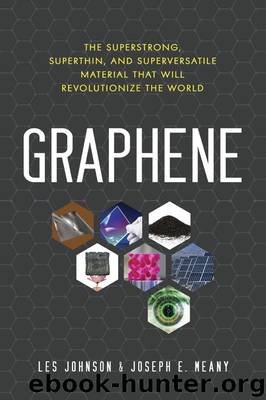Graphene by Les Johnson

Author:Les Johnson
Language: eng
Format: epub
ISBN: 9781633883260
Publisher: Prometheus Books
Published: 2018-01-09T05:00:00+00:00
POWER TRANSMISSION
Graphene is not a traditional superconductor, but it is close. A low-temperature superconductor, as its name implies, conducts electricity without loss at low temperatures—very low temperatures. In 1911, Dutch physicist Heike Onnes discovered curious properties of some materials when they are cooled to temperatures approaching absolute zero (~4 Kelvin or –269°C): their electrical resistance drops to zero (not approximately zero, but truly zero, as in there is no resistance), and they repel, or eject, lines of magnetic flux (they keep the magnetic field from penetrating). The temperature at which these effects occur is said to be the material's critical temperature (Tc).
Why is this important? Because we waste a great deal of the electricity we produce in transporting it from the place at which it is generated to the user. The amount of loss depends upon the resistance of the metal, which, as its name implies, resists the flow of current through it. Metals tend to have lower resistances than other materials, which is why we use them in our electrical appliances. You experience these losses in everyday life when you notice the power cord of a space heater or hair dryer getting warm. These uses for electricity to generate heat are intentional conversions. The materials in hair dryers or space heaters are intended to get hot from the power coming from a socket. Other losses are less noticeable, or at least less attributed to waste. Has your phone ever gotten hot while you used it a lot? Resistance inherent to the materials that make up the phone cause it to heat up while under stress. Incandescent lights throw off lots of heat—they get up to several hundred degrees Celsius (still several hundred degrees Fahrenheit). Some of you reading this may remember having the Easy Bake Oven or Creepy Crawlers as kids. There is a reason why they worked so simply, and it was due to an incandescent light heating the cake or critter. The thermal energy, heat, is produced as the electrical current in the wire encounters the resistance of the wire in the device that is intended to produce heat. In a device that isn't built to heat something, unlike the aforementioned examples, heat is energy lost to resistance, an inefficiency in the system. The holy grail of electrical physicists would be a material that has zero resistance even up to 37°C (about 100°F). That way, we could transport electricity from where it would be created cheaply (in very rural areas) to where it is needed most (in the most urban areas).
Everywhere in the world today, there are hundreds of thousands of kilometers of electrical power lines stretching in every conceivable direction, each of which loses energy at every centimeter as it conducts electricity to our homes, offices, and manufacturing facilities. According to the US Energy Information Administration, transmission and distribution losses in the United States totaled between 6 percent and 7 percent of all electricity produced. That doesn't even count the inefficiencies and losses in the appliances that use the electricity on the consumer side.
Download
This site does not store any files on its server. We only index and link to content provided by other sites. Please contact the content providers to delete copyright contents if any and email us, we'll remove relevant links or contents immediately.
| Automotive | Engineering |
| Transportation |
Whiskies Galore by Ian Buxton(41937)
Introduction to Aircraft Design (Cambridge Aerospace Series) by John P. Fielding(33092)
Small Unmanned Fixed-wing Aircraft Design by Andrew J. Keane Andras Sobester James P. Scanlan & András Sóbester & James P. Scanlan(32763)
Craft Beer for the Homebrewer by Michael Agnew(18196)
Turbulence by E. J. Noyes(7977)
The Complete Stick Figure Physics Tutorials by Allen Sarah(7336)
Kaplan MCAT General Chemistry Review by Kaplan(6899)
The Thirst by Nesbo Jo(6877)
Bad Blood by John Carreyrou(6581)
Modelling of Convective Heat and Mass Transfer in Rotating Flows by Igor V. Shevchuk(6406)
Learning SQL by Alan Beaulieu(6237)
Weapons of Math Destruction by Cathy O'Neil(6214)
Man-made Catastrophes and Risk Information Concealment by Dmitry Chernov & Didier Sornette(5956)
Digital Minimalism by Cal Newport;(5704)
Life 3.0: Being Human in the Age of Artificial Intelligence by Tegmark Max(5512)
iGen by Jean M. Twenge(5384)
Secrets of Antigravity Propulsion: Tesla, UFOs, and Classified Aerospace Technology by Ph.D. Paul A. Laviolette(5332)
Design of Trajectory Optimization Approach for Space Maneuver Vehicle Skip Entry Problems by Runqi Chai & Al Savvaris & Antonios Tsourdos & Senchun Chai(5037)
Pale Blue Dot by Carl Sagan(4953)
